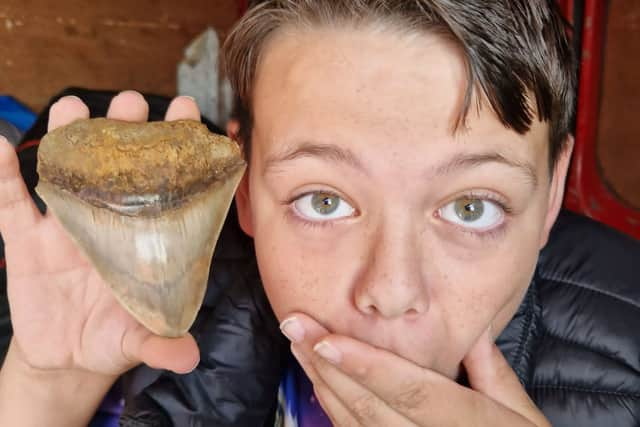Boy 'over the moon' to find Megalodon shark tooth on Essex coast up to 20 million years old
and live on Freeview channel 276
A truly extraordinary discovery has been made by a 13-year-old boy from Hemel Hempstead while he was searching for fossils on the Essex coast. While out with his dad Jason, schoolboy Ben was 'over the moon' to find a shark tooth that has been confirmed to belong to a prehistoric marine animal - the Megalodon.
The tooth was found at Walton-on-the-Naze nature reserve on the Essex coast where a number of similar fossils have been found - but these are usually fragments unlike this instance.
Advertisement
Hide AdAdvertisement
Hide AdThe Megalodon was a prehistoric shark that lived from around 20 million years ago to as recently as 3.6 million years. It is known to be one of the largest and most powerful predators in the Earth's history - at least three times bigger than a Great White shark and there no known predators that would have hunted it.
Jason - who takes Ben fossil searching at least once a year along the coast - described the moment Ben - who wants to become a palaeontologist - found the tooth.


The 50-year-old said: "Ben's mum is in hospital for chemotherapy so I took him away for a little break. We go fossil-hunting once a year.
"We walked a few miles and found the tooth on Sunday at around 7am. It was in a small hole that he had to crawl in. There's no way I could've fit in there, but he went in with a torch and could see it sticking out.
Advertisement
Hide AdAdvertisement
Hide Ad"He was jumping for joy and absolutely over the moon afterwards. We've never come across anything like that before.
"He was always digging up gravel as a kid and clearly has a good eye for fossils. There's a lot of questions he wants answered now and he's working hard to find out how it got there."
The megalodon's favourite foods were whales and seals, although its size meant it could eat pretty much what it pleased. It lived from a time around 45 million years after the dinosaurs became extinct.
The prehistoric giant shark could swim at high speeds in short bursts.
Advertisement
Hide AdAdvertisement
Hide AdEssex Wildlife Trust - which manages the Walton-on-the-Naze nature reserve - confirmed it was indeed from a megalodon shark.
A statement from the Trust read: "Pre-historic fossils are found often at the Naze, and we also run fossil-hunting events for those who are interested. It is an excellent area for fossil hunting, as the cliffs are made from 54-million-year-old London clay. We do sometimes have fragments of megalodon teeth found, but a whole tooth has only been found on a few occasions. Frequent finds include sand tiger shark teeth, some mackerel shark teeth and pyritised fossilized wood.
"We expect it is around 10 million years old, the megalodon existed around 3.6-20 million years ago so it will be from this time frame.
"We believe megalodons would have had an expansive range since megalodon teeth have been found in every continent except for Antarctica.
Advertisement
Hide AdAdvertisement
Hide Ad"We have had megalodon teeth before which are an incredible finding, as they represent physical evidence of the world's largest shark to have ever existed.
"Fossils are always an exciting finding, as they help us to build up the picture of these prehistoric creatures. Megalodon actually translates to ‘big tooth’, and they certainly live up to their name as compared to other shark teeth we have found. they are huge and some megalodon teeth have been known to reach just over 7 inches long."
Jason - whose family now own the tooth having found it - is aiming to take the tooth to the Natural History Museum so experts can work out more information as to where it has come from and the dating of the tooth.
Comment Guidelines
National World encourages reader discussion on our stories. User feedback, insights and back-and-forth exchanges add a rich layer of context to reporting. Please review our Community Guidelines before commenting.
